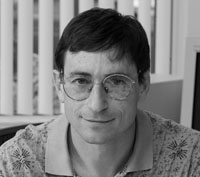NIH Award from the National Institute of General Medical Sciences
Kinetic Studies of Protein Folding
- Principal Investigator: Tobin Sosnick, PhD, Professor, Biochemistry & Molecular Biology; Director, Institute for Biophysical Dynamics
- Start Date: September 30, 2009
- Total Award Amount: $72,589
Public Health Relevance
Delineating folding mechanisms has tremendous implications for human health and biological function. The proposed research will identify the basic principles governing protein folding, including the nature of the early events leading to the rate-limiting step, and will use this information to predict pathways and structure without resorting to homology.
Project Description
Delineating folding mechanisms has tremendous implications for human health and biological function. Folding errors in vivo may be responsible for the loss of more than 30% of synthesized polypeptides, while misfolded conformers have been implicated in a large number of human diseases, including cancer and amyloidoses. The loss of protein stability is the cause of 75% of the monogenic diseases. In addition, the ubiquitous presence of folding chaperones testifies to the importance of the folding process in many cellular activities. The wide range of biological processes and diseases centered around protein folding emphasizes the importance of mechanistic studies of this universal process.
This current proposal will integrate experiment and simulations to address three outstanding questions concerning protein folding. Although there is a consensus that transition states (TSs) adopt a native-like topology, they have been described at times as polarized, expanded versions of the native state, either containing extensive amounts of secondary structure or formed in a general collapse around a diffuse nucleus. Does this diversity reflect reality? Or is it the consequence of inadequate methods to probe the TS, and a more coherent picture exists to describe TSs? Even more uncertainty surrounds the early steps leading up to the TS - is there is a collapse occurring via multiple, diverse routes represented by broad funnel, or is there a dominant ordered pathway with a sequential build-up of H-bonded structure, as we have proposed for ubiquitin? From the computational standpoint, can an algorithm that mimics the folding process predict pathways and, consequently, native structures without utilizing homology?
In Aim 1, we will test our prediction that 70% of the native topology is present in the TS of many proteins and then investigate the origin of the 70% level. To do this, we will apply our ?-analysis method to characterize a selected set of naturally occurring and designed proteins. In Aim 2, we will advance an algorithm that utilizes the folding process to predict pathways and structure without resorting to homology, and in the process test various folding models. In Aim 3, we will rationally populate early and late intermediates and characterize them using NMR hydrogen exchange and relaxation dispersion methods. We will perform a "protein autopsy" in which buried Leu?Glu- mutations drive a pH-dependent subglobal unfolding to populate late intermediates.
This award is funded under the American Recovery and Reinvestment Act of 2009, NIH Award number: 3R01GM055694-14S1

Tobin Sosnick, PhD,
Professor, Biochemistry & Molecular Biology; Director, Institute for Biophysical Dynamics
